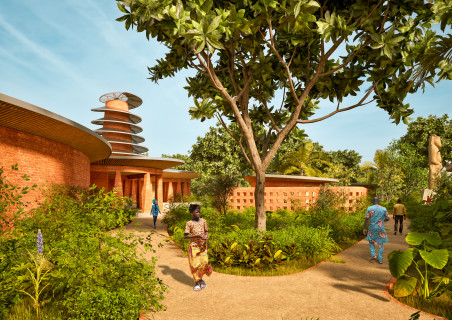Press release
KÉRÉ ARCHITECTURE REVEALS DESIGN FOR THE CENTRE DES CULTURES ET SPIRITUALITÉS EWÉS IN NOTSÉ, TOGO
Notsé, Togo, December 4, 2024 – Kéré Architecture reveals its design for a masterplan and series of buildings for a cultural center honoring the heritage of the Ewé people in the town of Notsé, in Togo. The construction of the Centre des Cultures et Spiritualités Ewés (CCSE) has begun, was commissioned by the Kothor Foundation, and will house a sanctuary, temples, an open-air amphitheatre, a reception area, exhibition halls, an auditorium, restaurants, and a reconstruction of the ancient royal palace of the Ewé Kingdom. The primary material used for buildings is red laterite brick, which is abundant locally, durable, and well-suited to Togo’s climate.
The center’s program will offer new perspectives on the history, ancestral rites, and traditions of the Ewé people. Kéré Architecture’s masterplan is organized around the remnants of the historic Agbogbo wall—a sacred enclosure whose construction played a pivotal role in the exodus of the Ewé people—and the Agbogbodzi Sanctuary, which honors their principal deity. The wall’s origins are rooted in conflict, serving both as a means of containing the king's subjects and as a protective barrier against the threat of enslavement by other tribes.
At the site dedicated to this sacred presence, a tower whose spiral form symbolizes an upward connection links the divinity to the ancestors and heavens. The various elements of the masterplan are grouped together in fluid, low-rise buildings that wind through the landscape on either side of the wall, punctuated by patios with plantings that allow for natural ventilation.
Notsé was founded by the Ewé people in the seventeenth century and is located about 80 kilometers north of Lomé, Togo’s capital. It was the origin of the Ewé people before their exodus from Notsé to other regions in Togo, and to Benin and Ghana. Every first week of September since 1956, Notsé has been a gathering place for Ewé pilgrims as they celebrate the Agbogbozan festival, commemorating the exile of their ancestors and celebrating togetherness.
The exhibition halls of the Centre des Cultures et Spiritualités Ewés are dedicated to historical artefacts of Ewé culture, preserving Ewé knowledge while also showcasing contemporary works. A system of natural light shafts set into the ceiling creates a filtered and ambient lighting effect across these halls. An emblematic gateway, inspired by the Ewé stool, a royal chair that symbolises power, marks the main entrance to the site.
Kokou Djifanou Kothor, Kothor Foundation: “If we value our traditions and reconnect to our roots for a better tomorrow for our communities, Africa will gain much and the world will be better off. We believe that to honor our traditions is to place the light of the past into the hands of the present in order to illuminate the future.”
Francis Kéré: “I am very happy to contribute to this important project, and to be able to support this initiative of giving a space to express and preserve identity. It is a joy to see how ideas and techniques embedded within my work have now become 'salonfähig' and widely accepted by people building on the continent. The centre will demonstrate how architecture can be a catalyst for communities to celebrate their cultures.”
This is the studio’s first project in Togo. Construction started in October of 2024, with the project completing in February of 2026. Other projects by Kéré Architecture currently underway in West Africa are the Benin National Assembly, the Goethe Institute in Dakar, and a mausoleum for Thomas Sankara in Ouagadougou, Burkina Faso’s capital.
PROJECT FACTS AND CREDITS
Location: Notsé, Togo
Type of Project: Private – Place of Worship and Cultural Center
Size: 7,000 m²
Design: 2022–2024
Construction: 2024–ongoing
Status: Under construction
Architect: Diébédo Francis Kéré, Kéré Architecture
Design Team: Jaime Herraiz Martínez, Andrea Maretto, Léa Sodangbe
Engineering Team: Nataniel Sawadogo, Jean Sawadogo, Moïse Kéré Architecture SARL (Ouagadougou, Burkina Faso)
Contributors: Jeanne Autran-Edorh, Philippe Chazée, Yonas Tukuabo, Leonne Voegelin, Sika Azamati
Project Management: Jaime Herraiz, Nataniel Sawadogo, Alimadjai Boukari
Collaborators: APAVE BCT (Burkina Faso), Ingenovatech (Burkina Faso)
Client: Fondation Kothor / LA GMA SA
-
Aerial view rendering, looking east | © Kéré Architecture
-
Aerial view rendering, looking north | © Kéré Architecture
-
Big Temple rendering | © Kéré Architecture
-
Café rendering | © Kéré Architecture
-
Salon d'Art rendering – view from corridor | © Kéré Architecture
-
Salon d'Art rendering – view into courtyard | © Kéré Architecture
-
Sanctuary rendering – exterior view | © Kéré Architecture
-
Small Temple rendering | © Kéré Architecture
-
Statue rendering | © Kéré Architecture
-
Ticket Store rendering – exterior view | © Kéré Architecture
-
Ticket Store rendering – interior view | © Kéré Architecture
-
Axonometry of the entire complex | © Kéré Architecture
-
Masterplan | © Kéré Architecture
-
Program in English | © Kéré Architecture
-
Program in French | © Kéré Architecture
-
Axonometry of the Main Entrance | © Kéré Architecture
-
Plan of the Main Entrance | © Kéré Architecture
-
Section of the Main Entrance | © Kéré Architecture
-
Axonometry of the Museum | © Kéré Architecture
-
Plan of the Museum | © Kéré Architecture
-
Section of the Museum | © Kéré Architecture
-
Axonometry of the Amphitheatre | © Kéré Architecture
-
Plan of the Amphitheatre | © Kéré Architecture
-
Section of the Amphitheatre | © Kéré Architecture
-
Axonometry of the Sanctuary | © Kéré Architecture
-
Plan of the Sanctuary | © Kéré Architecture
-
Section of the Sanctuary | © Kéré Architecture






























